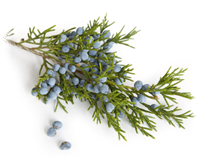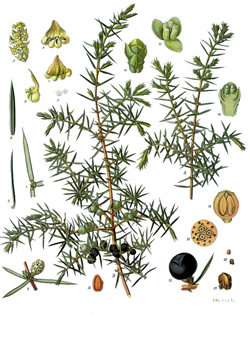Juniper Juniperus communis

- Common Names
- Juniper Berries
- Botanical Name
- Juniperus communis
- Family
- CUPRESSACEAE
Medicinal Uses & Benefits of Juniper Berries
![]() How to Use|
Side Effects |
Plant & Garden|
Aromatherapy Oil |
How to Use|
Side Effects |
Plant & Garden|
Aromatherapy Oil |
- Medicinal Uses: * Acne
* Aromatherapy
* Bladder Infection (UTI)
* Cellulite
* Colds
* Congestion
* Detoxification
* Eczema
* Facial Care
* Gout
* Herbal Steam
* Nerve/Back Pain
* Rheumatoid_arthritis
- Properties: * Antibacterial * Antirheumatic * Antispasmodic * AntiViral * Aphrodisiac * Aromatic * Astringent * Cicatrisant * Circulation * Depurative * Diaphoretic * Diuretic * Emmenagogue * Energize * Mental Clarity * Nervine * Rubefacient * Sedative * Skin tonic * Stomachic * Vermifuge * Vulnerary
- Parts Used: berries
- Constituents: volatile oil (major components pinene, myrcene, sabinene, also limonene, terpinene, camphene and thujone), sugars, vitamin c, flavonoids, resin, gallotannins
How to Use: Juniper
Juniper closely resembles cypress, and like cypress it is valued for its detoxifying action on the body. The use and reputation of juniper berries and their own is ancient, yet few human studies have been done. Many Native American tribes of North America have traditionally used juniper for a wide range of ailments. Herbalgram
Juniper helps to eliminate excess water and is used as a mild diuretic to treat to treat urinary problems, usually in combination with other herbs. In 1984, the German Commission E approved the use of juniper dried fruit in teas and extracts to relieve dyspepsia (disturbed digestion or indigestion), but did not approve juniper as a single-ingredient aquaretic (an agent that increases urine flow, without affecting electrolyte balance). Juniper's detoxifying properties are also employed in the treatment of wounds and inflamatory diseases such as gout and rheumatoid arthritis and according to studies inhibited the formation of inflammatory prostaglanins. (Tyler, 93)
In addition juniper berries help clear congestion so are often included in cold remedies to relieve congestion and improve breathing Indeed, juniper berries have such a wide range of uses that no herbal medicine chest should be without them.
Preparation Methods & Dosage : To prevent loss of essential oil, juniper berries should not be ground, crushed, or rubbed until just before use. Juniper essential oil is for external applications only.
Juniper Remedies
Juniper : Essential Oil Profile
Juniper berry oil has a fresh, warm, balsamic, woody-pine needle odor. Juniper is noted as being a detoxifying essential oil and is often used in massage formulas for pain. Juniper oil is also astringent, anti-inflammatory and antiseptic and can be very beneficial in cleansing and toning the skin in cases of acne and other skin inflammations such as eczema. Juniper oil has a strengthening, tonic effect on the nerves, its sedative action will help those who find sleeping difficult because of worries and tensions. (Tisserand, Robert B. "Art of Aromatherapy")
- Anticellulite Bath Synergistic Blends
- Anticellulite Massage Oil Formulas
- Astringent oil acne treatment
- Detoxifying Oil Blend
- Essential Oils for Congestion
- Rosemary pain blends
- Tension Headache Relief
- Warming Massage Pepper Oil
- Warming Oils for Pain
- Yule Purifying Blend
Juniper Side Effects: Not for use during pregnancy or where there is kidney disease. If your urine smells like violets, you have been using the herb too long. Continued overdose can cause kidney irritation and blood in the urine. Use juniper berry essential oils in external applications only.
Plant Description

Koehler's Medicinal-Plants 1887
The Juniper is a small shrub, 4 to 6 feet high, widely distributed throughout the Northern Hemisphere.
Regional Traditions :European *
How to Grow Juniper
Juniper belongs to a variable genus of about 50 species, many of which are planted as ornamentals. Many varieties on sale at the nursery are propagated from male plants and do not bear the medicinal berries valued in herbalism.
History and Traditions & Folklore
Many Native American tribes of North America have utilized various parts of J. communis for a wide range of ailments.5 A decoction of the berries has been used for lung and venereal disease by the Blackfoot tribe. The Woodland Cree smoked the blue berries for asthma and have made a decoction of the green berries for sore backs caused by kidney trouble. A combination of the berries with kinnikinnick (Arctostaphylos uva-ursi, Ericaceae) leaves or balsam has been decocted, strained and used for tuberculosis by the Carrier tribe. The Inupiat have used the berries alone or as an infusion, or a decoction of the berries, needles and twigs, to prevent and treat colds and flu. 1 (HerbalGram)- HerbalGram.2009;82:1-2 . Juniper Berry , American Botanical Council, (2009): The European Medicines Agency (EMEA) draft monograph proposes therapeutic indications for juniper fruit or preparations of juniper (e.g. herbal tea, 1:1 liquid extract with 25% ethanol, and 1:5 tincture with 45% ethanol) that are intended as traditional herbal medicinal products to increase urine for flushing of the urinary tract as an adjuvant in minor urinary tract complaints, and as traditional herbal medicinal products for symptomatic relief of digestive disorders such as dyspepsia and flatulence,

- Robbers, James E. ,PhD, Tyler, Varro E. PhD,ScD. "Tylers Herbs of Choice" Hawthorn Herbal Press, (1999) Juniper is the most active but also the most potentially toxic of the volatile-oil-containing berries used to treat infections of the urinary tract pp93-94
- Mabey, Richard. "New Age Herbalist, The " Fireside, (1988) External frictions (massage) of the diluted essential oil ease neuralgia, sciatica and rheumatic pains. Juniper essential oil promotes elimination of uric acid making it useful in treatment of gout and rheumatoid arthritis. p56











